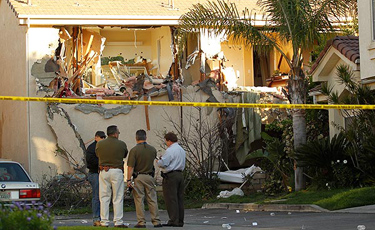
LAPD investigators look at the back of the Sylmar house Tuesday morning where a gunman suspected of critically wounding a Los Angeles police officer was found dead Monday night. The man had been holed up for nearly a day in the house as authorities fired tear gas and finally used a hydraulic forklift to rip open the home's walls. (Al Seib / Los Angeles Times / April 5, 2011)
A gunman who critically wounded a Los Angeles police officer was found dead Monday night inside his Sylmar home, where he had been holed up for nearly a day as authorities fired tear gas and used a hydraulic forklift to rip open the house.
The standoff, which began early Monday after officers responded to a domestic violence call, ended when Sergio O. Salazar's body was found on the second floor with a rifle at his side, the Los Angeles Police Department said.
An LAPD source said it was unclear how many wounds Salazar had sustained.
Salazar's body was discovered by a robotic camera used to search the residence in the 13600 block of Dronfield Avenue. Records show he was co-owner of the house.
Officers had responded to a call from Salazar's wife, the LAPD said.
Officer Steve Jenkins was shot once in the jaw and once in the shoulder as he and his canine team approached the home. Salazar had refused to step out and opened fire on the officers, according to the LAPD. Officers returned fire.
Jenkins underwent surgery at Holy Cross Medical Center in Mission Hills. The first bullet tore into the right side of his face and exited near his jaw, Dr. Bradley Roth said. The second bullet fractured several ribs and damaged a lung, Roth said.
Such medical information normally is private, but Jenkins' wife, an LAPD sergeant, gave surgeons permission to talk to the media.
Roth said people with injuries like Jenkins' typically survive but noted that the 22-year veteran was still "critically ill."
Court records show that Salazar was convicted in 1993 of one misdemeanor count of carrying a loaded firearm in a public place. A resident at that time of Littlerock in the Antelope Valley, he had been charged on two misdemeanor firearm counts and a misdemeanor count of failing to obey a court order, according to the records filed in Los Angeles County Superior Court.
A woman who lived next door in Sylmar said Salazar "used to carry a .357 [handgun] under the seat of his car."
Salazar had a tight-knit family, she said, including a mother and two sisters who adored him.
"He was the king of the family," said the woman, who asked not to be indentified because she feared for her safety.
The encounter began about 10:30 p.m. Sunday. Firefighters treated Salazar's wife for cuts and bruises at a neighbor's house, authorities said. After Salazar didn't respond to authorities' attempts to contact him inside the home, officers approached the house about 2:45 a.m., and Salazar opened fire, the LAPD said
About 6 a.m., the suspect communicated by text with relatives, said LAPD spokesman Andy Neiman. Contact ended after that, he said. Negotiators repeatedly tried to call Salazar on his cellphone and home phone, to no avail.
The neighborhood of middle-class ranch properties and Salazar's newer gated community was evacuated by 7 a.m. During the hours-long standoff, police fired tear gas into the home.
Salazar could be seen moving around, and he fired repeatedly on officers over a 45-minute to one-hour period ending at 10:30 a.m. Police did not see him after that, Neiman said.
About noon, SWAT units brought in a giant forklift-like machine and broke down part of the house's back wall to better expose the shooter.
The device, called a Bat Cat, broke down walls in several places upstairs and downstairs and was used to remove furniture and clear the area. The machine has a telescoping arm with video capability to monitor inside the house.
"The idea is to make it as wide open as we can so they can see him either down or not," Neiman said. "Whether he's hiding out playing possum or waiting for us to come in ... we just don't know."
Officers were using the Bat Cat to avoid a situation similar to what occurred in February 2008, when SWAT Officer Randall Simmons was killed and another officer critically wounded by a gunman who had barricaded himself inside a Reseda home, an LAPD official said.
Although an LAPD report showed that officers acted appropriately in that incident, a department official noted that Simmons was shot after storming through a narrow entryway.











